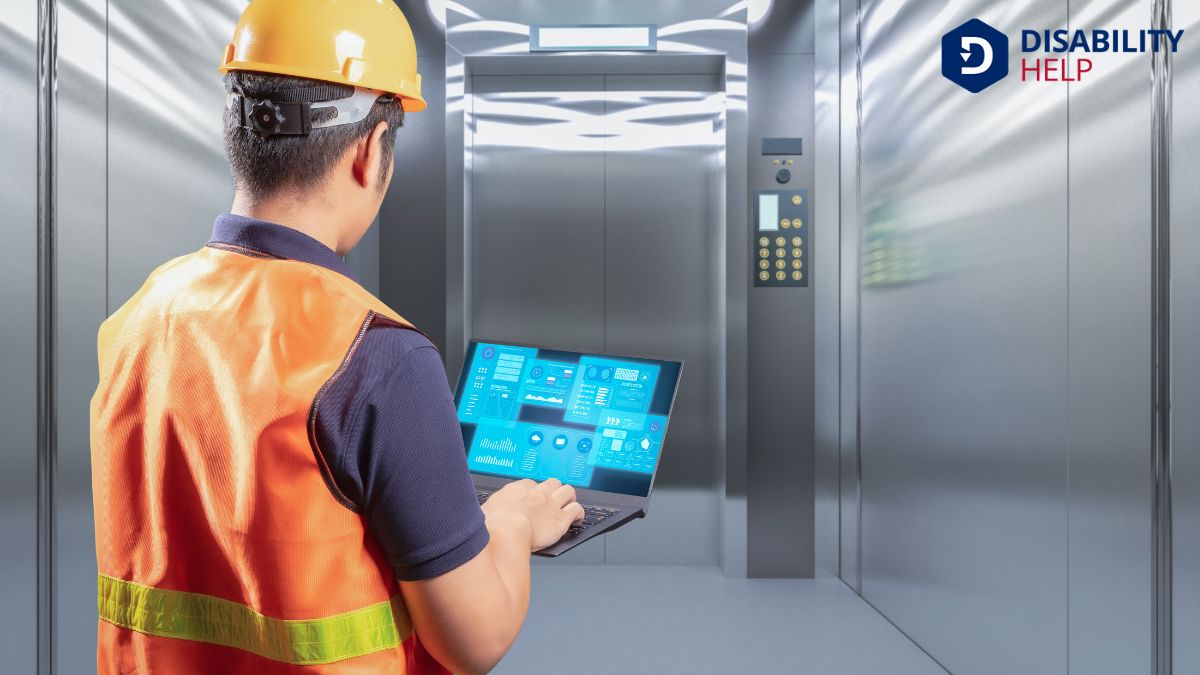When it comes to improving accessibilityThe design of products, devices, services, or environments to be usable by people with disabilities.... in our homes, stair lifts are often the go-to solution. But did you know there are several other options available? From home elevators that add value and ease of movement to modular ramps that offer a cost-effective alternative, the possibilities are diverse. Let's explore these alternatives together and discover which option might best fit your needs and lifestyle.
Key Takeaways
- Home elevators provide seamless navigation between floors and enhance accessibility and home value.
- Vertical platform lifts offer direct vertical movement for wheelchair users and mobility device users.
- Modular ramps are customizable, weather-resistant, and affordable solutions for enhancing home accessibility.
- Portable stair climbers offer flexibility and mobility assistance without permanent installations.
- Ceiling lifts provide smooth transitions between beds and wheelchairs, saving floor space.
Home Elevators

When considering alternatives to stair lifts, home elevators often come to mind as a practical and stylish solution. They provide a seamless way to navigate between floors, enhancing both accessibility and home value.
We can appreciate how these elevators fit various home designs while offering comfort and convenience. They’re particularly beneficial for those with mobility issues, ensuring everyone can move freely within their homes.
Home elevators come in different types and sizes, allowing us to choose one that matches our specific needs and architectural constraints.
Installation might seem challenging, but professional services simplify the process, ensuring safety and reliability.
Platform Lifts
Platform lifts offer another excellent alternative for enhancing home accessibility.
They're particularly useful for those who use wheelchairs or have mobility issues. These lifts are versatile and can be installed indoors or outdoors, providing a practical solution for traversing between different levels of a home.
Let’s explore some key benefits of platform lifts:
- Space-efficient: Ideal for homes with limited space, avoiding the need for extensive renovations.
- User-friendly: Simple controls make operation easy for everyone.
- Customizable: Available in various sizes and styles to suit individual needs.
- Safe: Equipped with safety features like emergency stop buttons and non-slip surfaces.
- Cost-effective: Often more affordable than full home elevators.
Modular Ramps
Although not as elaborate as other solutions, modular ramps offer a straightforward and efficient way to enhance accessibility in the home. They’re particularly useful for individuals who rely on wheelchairs or walkers, providing an easy passage from one level to another.
We can assemble these ramps quickly, and they’re often customizable to fit different spaces. Made from durable materials, modular ramps are built to withstand various weather conditions, making them suitable for both indoor and outdoor use.
Let’s also consider the cost-effectiveness of modular ramps. They’re generally more affordable than other mobility solutions, and installation doesn’t require major home modifications.
Incline Platform Lifts
Let's explore incline platform lifts as an efficient alternative to traditional stair lifts.
They offer a space-saving design that fits well in narrow stairwells while accommodating various weight capacities to meet different needs.
We'll also cover the installation requirements to guarantee a smooth setup in your home.
Space-Saving Design Benefits
When considering alternatives to traditional stair lifts, incline platform lifts offer a compelling space-saving solution for those with mobility challenges.
These lifts are designed to utilize minimal space while providing essential accessibility. Their sleek design integrates seamlessly into stairways, preserving valuable floor area.
We acknowledge the importance of maintaining a functional and comfortable home environment, and incline platform lifts meet this need effectively.
Here are some benefits of their space-saving design:
- Compact installation: Fits closely to the wall or railing, maximizing stairway space.
- Foldable platform: Stows away when not in use, keeping the pathway clear.
- Minimal structural changes: Requires less modification to existing staircases.
- Versatile use: Suitable for both indoor and outdoor installations.
- Aesthetic appeal: Blends with home decor, maintaining style.
Weight Capacity Considerations
While incline platform lifts offer impressive space-saving benefits, weight capacity remains a key consideration for confirming safety and functionality.
We need to think about the combined weight of the user, any mobility device, and other items they may carry. Most incline platform lifts can handle weights ranging from 400 to 750 pounds, but it's essential to verify the model's specifications.
Let’s ascertain the lift meets our unique requirements by considering future needs, like potential changes in mobility equipment.
Safety features, such as overload sensors, can provide peace of mind by preventing the lift from operating beyond its capacity.
We should consult with a knowledgeable provider to find the best option that accommodates our specific needs and guarantees a safe, smooth experience.
Installation Requirements Overview
Before we plunge into installing an incline platform lift, it’s vital to understand the specific requirements to guarantee a seamless setup.
These lifts can be a marvelous solution for those who find stairs challenging, but they do come with certain prerequisites.
Let’s walk through the significant elements that we need to take into account:
- Staircase Width: Verify there’s enough space to accommodate the platform without obstructing the passage.
- Structural Integrity: Confirm the staircase and walls are sturdy enough to support the lift.
- Power Supply: A dedicated electrical source is necessary for the lift’s operation.
- Landing Space: Adequate room at the top and bottom for safe entry and exit.
- Permits and Regulations: Check local codes to guarantee compliance with legal requirements.
Focusing on these aspects will lead us to a successful installation.
Vertical Platform Lifts
For those seeking a practical and efficient solution to accessibility challenges, vertical platform lifts offer a compelling alternative to traditional stair lifts. Unlike stair lifts that follow the staircase, these lifts provide direct vertical movement, making them ideal for individuals using wheelchairs or mobility devices.
They accommodate a wider range of needs by offering a larger platform, which can transport both a person and their mobility equipment safely.
We appreciate the flexibility and ease of installation of vertical platform lifts. They can be installed indoors or outdoors, depending on our specific requirements.
With various models available, we can choose one that fits our space and aesthetic preferences. Additionally, these lifts enhance independence by allowing users to navigate different levels of a building with minimal assistance.
Ceiling Lifts
Let's explore ceiling lifts as a space-saving alternative to traditional stair lifts.
They offer versatility, allowing us to move between rooms without taking up floor space.
With features focusing on safety and comfort, ceiling lifts provide a reliable solution for easier home navigation.
Space-Saving Installation Benefits
While traditional stair lifts can be cumbersome and occupy valuable space, ceiling lifts offer a remarkable space-saving solution for mobility needs.
By installing a ceiling lift, we can free up our home's floor space, making it easier to navigate without obstructions. These lifts are mounted overhead, eliminating the need to modify staircases or hallways. This allows us to maintain the home’s original aesthetics.
Plus, ceiling lifts can be a more discreet option, blending seamlessly into our living environment.
Consider the following space-saving benefits:
- Preserves floor space: No tracks or chairs on the stairs.
- Flexible installation: Fits various ceiling heights and widths.
- Minimal structural alteration: Less invasive to our home.
- Enhanced room accessibility: Moves freely across rooms.
- Compact design: Out of sight when not in use.
Versatility in Home Use
Ceiling lifts offer unmatched versatility in home use, adapting to our diverse mobility needs with ease.
They seamlessly integrate into any room, facilitating movement across different spaces without the need for floor tracks or large equipment.
Whether we’re transferring between a bed and a wheelchair or moving across multiple rooms, ceiling lifts provide a smooth changeover.
Safety and Comfort Features
When considering safety and comfort features, ceiling lifts truly stand out by prioritizing user well-being and ease of use. They offer a seamless experience, providing individuals with mobility challenges the freedom to navigate their homes safely.
Let’s explore some key features that make ceiling lifts a compelling alternative:
- Smooth Operation: Ceiling lifts move quietly and effortlessly, ensuring a peaceful passage.
- Remote Control: Users can control the lift with ease, enhancing independence.
- Emergency Stop: Built-in safety mechanisms allow for immediate halting if needed.
- Comfortable Sling: Designed for maximum support, the sling cradles the user securely.
- Space Efficiency: Mounted on the ceiling, these lifts save floor space, maintaining home aesthetics.
Portable Stair Climbers
Portable stair climbers offer a versatile and convenient solution for those seeking mobility assistance without the permanence of a traditional stair lift. They’re perfect for individuals who need temporary help or move frequently.
These devices are designed to be lightweight, making them easy to transport and store when not in use. We can simply place them on the stairs when needed, allowing for quick and efficient navigation up and down.
With a variety of models available, we’ll find some that accommodate different weight capacities and stair types. They’re powered by rechargeable batteries, ensuring smooth operation without being tethered to an outlet.
For those of us who want flexibility in mobility assistance, portable stair climbers provide an effective and practical option.
Robotic Assistance
Although stair lifts have long been a staple for enhancing mobility, robotic assistance is emerging as an innovative alternative.
These technologies can redefine how we navigate spaces by providing personalized support and increased independence.
Let’s explore some benefits of robotic assistance:
- Adaptability: Robots can be programmed to handle various tasks, adjusting to different user needs.
- Safety: Advanced sensors help detect obstacles, preventing accidents and ensuring safe passage.
- Comfort: Many robots are designed to provide a smooth and comfortable experience, minimizing strain.
- Independence: Users gain the freedom to move around without waiting for help, promoting a sense of autonomy.
- Innovation: Continuous advancements in technology mean these solutions are becoming more efficient and user-friendly.
Robotic assistance offers a promising future for mobility solutions.
Outdoor Stair Solutions
As we consider outdoor stair solutions, it's important to recognize the unique challenges that external environments present. Weather conditions, uneven surfaces, and exposure to the elements can impact the functionality and safety of any solution we choose.
One effective alternative is installing ramps. They're versatile and can be tailored to fit various spaces, ensuring ease of use for wheelchairs, scooters, and pedestrians.
We should also explore outdoor stair climbers, which provide mobility assistance without the need for permanent installations. These devices can be particularly beneficial in areas where space is limited or terrain is challenging.
Additionally, handrails with non-slip surfaces offer essential support and stability, vital in wet or icy conditions.
Customized Home Modifications

Let's explore how customized home modifications can be effective alternatives to traditional stair lifts.
By considering ramp installation options, elevator alternatives, and adaptive furniture solutions, we can create a safer and more accessible environment.
Together, we'll find the best fit for our unique needs and preferences.
Ramp Installation Options
When considering alternatives to stair lifts, ramp installation options offer a practical and customizable solution for improving home accessibility.
By opting for ramps, we can accommodate various mobility needs while maintaining a seamless change between levels. Ramps are particularly beneficial for those using wheelchairs, walkers, or other mobility aidsDevices designed to help individuals move around more easily, such as canes, walkers, or wheelchairs....
Let's explore some key factors for ramp installations:
- Material Choices: Options include wood, aluminum, or concrete, each with unique benefits.
- Slope and Length: Proper slope guarantees safety and ease of use; typically, a 1:12 ratio is recommended.
- Space Considerations: Assess available space to determine the best ramp configuration.
- Weather Resistance: Choose materials and designs that withstand local weather conditions.
- Aesthetic Integration: Ramps can be designed to blend with your home's exterior.
These considerations help guarantee our ramp installation meets all our needs.
Elevator Alternatives
While stair lifts and ramps have their merits, exploring elevator alternatives can offer a more thorough solution for home accessibility. Elevators can provide seamless movement between floors, accommodating wheelchairs, walkers, or simply those who find stairs challenging.
We should consider options like pneumatic vacuum elevators, which are compact and don’t require a machine room, or the more traditional hydraulic and traction models for larger homes.
Installing an elevator might seem intimidating, but it's about creating a space that meets our specific needs. We’ll need to evaluate structural modifications, budget, and design preferences.
Consulting with professionals guarantees safety and compliance with building codes. By customizing our home, we can enjoy increased independence and comfort, making daily life easier and more enjoyable for everyone.
Adaptive Furniture Solutions
Adaptive furniture solutions are a transformative part of home modifications that can greatly enhance accessibility and comfort.
By focusing on customized options, we can tailor our living spaces to meet specific needs without the need for a stair lift.
Let’s explore some options that can make a big difference:
- Adjustable height desks: Perfect for changing positions from sitting to standingThe legal right to bring a lawsuit, which requires that the individual bringing the suit has a direc....
- Reclining chairs with lift assistance: Eases the shift from sitting to standing.
- Wall-mounted foldable tables: Save space and offer flexibility.
- Customized shelving: Guarantees items are within easy reach and reduces strain.
- Easy-access kitchen cabinets: Features like pull-down shelves improve usability.
Conclusion
In exploring alternatives to stair lifts, we've discovered a variety of options tailored to enhance accessibility in our homes. From home elevators that boost property value to modular ramps offering cost-effective flexibility, there's something for everyone's needs. Vertical and incline platform lifts cater to wheelchair users, while portable stair climbers provide temporary solutions. Let's not forget about robotic assistance and outdoor stair solutions, ensuring we're prepared for every situation. Together, we can create spaces that are both functional and welcoming.






